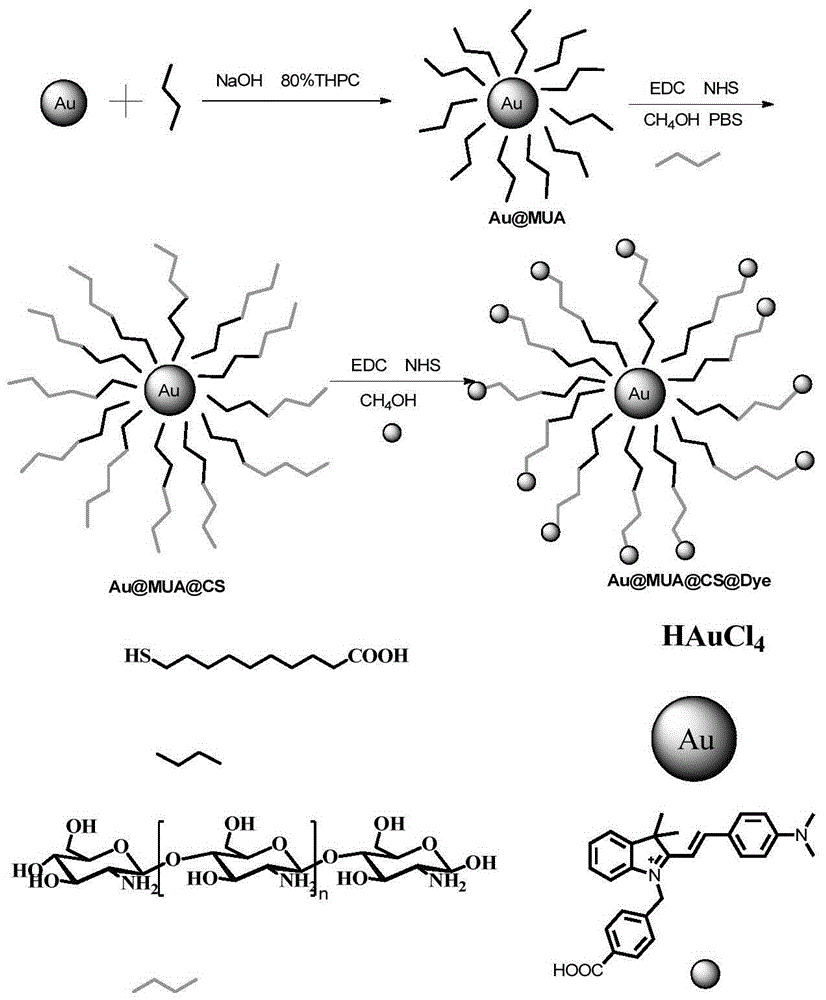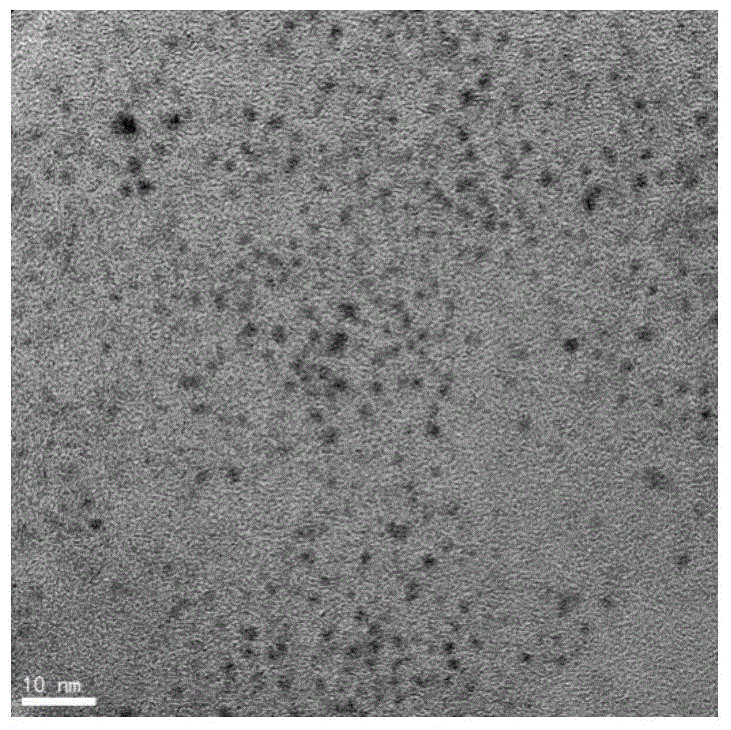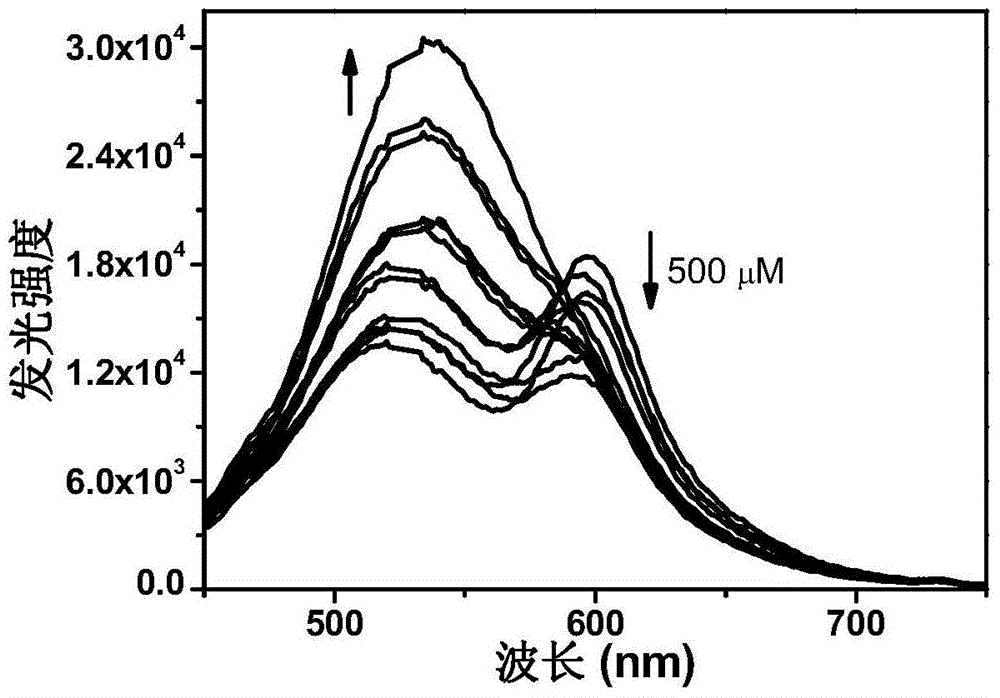A kind of sulfhydryl ion nanoprobe material and its preparation method and application
A nanoprobe, hydrogen sulfide technology, applied in nanotechnology, nanotechnology, analytical materials, etc., can solve the problems of inability to detect hydrogen sulfide, poor photostability, toxicity, etc., to eliminate background fluorescence interference, good dispersion, Small particle size effect
- Summary
- Abstract
- Description
- Claims
- Application Information
AI Technical Summary
Problems solved by technology
Method used
Image
Examples
Embodiment 1
[0033] Embodiment 1. A kind of sulfhydryl ion nanoprobe material, the specific preparation route is as follows:
[0034] S1. Preparation of gold nanoclusters (Au@MUA) with undecylmercaptoalkanoic acid as ligand:
[0035] 1. Add 13.1mg 11-MUA and 200μL 1M NaOH into 20mL water and dissolve completely.
[0036] 2. Add 510 μL (1% by mass) HAuCl4 and 445 μL THPC (80% aqueous solution, 12 μL water is added to 1 mL water to dissolve), the solution is stirred at room temperature for 2 hours, and the solution turns yellow.
[0037] 3. Add 10 mL of 500 mM NaCl aqueous solution to the obtained product, centrifuge at 6000 g for 15 min, remove the supernatant, and wash the precipitate twice with water and ethanol (V water: V ethanol = 2:1) to obtain the final purified product.
[0038]
[0039] S2. Modified chitosan molecules on the obtained Au@MUA to obtain gold nanoclusters (Au@MUA@CSa):
[0040] The Au@MUA 2mL solution obtained above was activated by adding 0.25mL 0.05M EDC and 0.2...
Embodiment 2
[0045] Example 2. Morphological characterization
[0046] Samples were prepared respectively according to the above specific steps, and the sample solution was dropped on the copper grid, and after drying, the morphology test was carried out, such as figure 2, it can be found that the particle size of various gold nanoclusters prepared is 1-2nm, and the dispersibility is very good.
Embodiment 3
[0047] Embodiment 3. Spectral test
[0048] The fluorescence emission spectrum test of the gold nanocluster material on the covalent bond modification to the sulfhydryl ion: take 200ul of PBS buffer solution dispersed with the gold nanocluster in the cuvette, gradually add the sulfhydryl ion (NaHS dissolved in PBS solution), such as image 3 Fluorescence emission spectra were measured.
[0049] Test the response of gold nanocluster materials modified by covalent bonds to different anions: take 200uL PBS buffer solution dispersed with gold nanoclusters in a cuvette, add 2uL 10 -2 M of F - , Cl - 、Br - , NO 3 - , NO 2 - , oAC - 、SCN - 、HPO 4 - , SO 4 2- , CO 3 2- , S 2 o 3 2- , HClO 4 - 、H 2 o 2 , NO, Gly and 2uL 10 -1 M Hcy, Cys, GHS, HS - 、GHS+HS - 、Cys+HS - , the measured fluorescence emission spectrum as Figure 4 .
[0050] According to the response spectrum of gold nanocluster materials modified by covalent bonds to sulfhydryl, it can be seen t...
PUM
| Property | Measurement | Unit |
|---|---|---|
| particle diameter | aaaaa | aaaaa |
| size | aaaaa | aaaaa |
Abstract
Description
Claims
Application Information
 Login to View More
Login to View More - R&D
- Intellectual Property
- Life Sciences
- Materials
- Tech Scout
- Unparalleled Data Quality
- Higher Quality Content
- 60% Fewer Hallucinations
Browse by: Latest US Patents, China's latest patents, Technical Efficacy Thesaurus, Application Domain, Technology Topic, Popular Technical Reports.
© 2025 PatSnap. All rights reserved.Legal|Privacy policy|Modern Slavery Act Transparency Statement|Sitemap|About US| Contact US: help@patsnap.com



